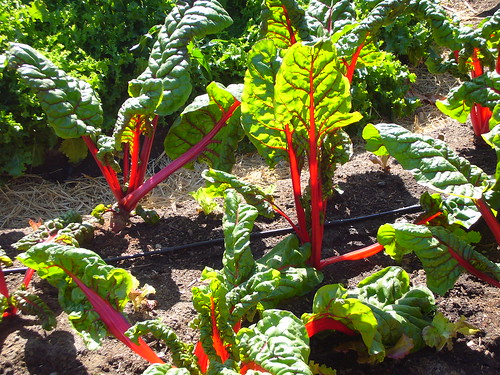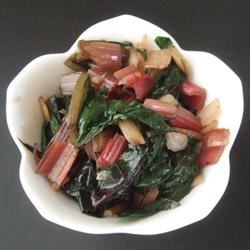Cropedia:Chard
Chard
" "
"
Source: http://www.flickr.com/photos/51314692@N00/2812546546/
Years grown at UBC Farm/LFSOG: #
Growing conditions
- Chard likes to be grown on ordinary garden soil in sun or partial shade. It can be grown almost all temperatures, except for extreme cold or hot conditions
To sow chard, draw a row or line in the bed soil no more than 2.5cm (1inch) deep. It is important to sow thinly so they have room to establish. When chard have two or more leaves, thin the leaves to 5cm for small leaves, and 10cm apart for larger leaves. It is important to well moist.
It will take approximately 12 weeks to grow. To harvest, pull off individual leaves ("Igrowveg," 2009).
Seasonality
- Chard is grown in late spring, usually in between April to May.
Nutritional Information
Chard is valuable dietary supplement for vegans and vegeterians. Chard is rich source of minerals including magnesium, calcium, vitamin K, iron, potassium, vitamin A, folate, zinc, copper, vitamin C, dietary fiber, and vitamin E (Smith, 2010).
| Nutrition Facts/Valeur Nutritive | |
|---|---|
| Serving Size: 36 g | |
| Amount Per Serving | %Daily Value* |
| Calories 7 | |
| Total Fat 0g | 0% |
| Saturated Fat 0g | 0% |
| Trans Fat 0g | |
| Cholesterol 0mg | |
| Sodium 77mg | 3% |
| Total Carbohydrate 1g | 0% |
| Dietary Fiber 1g | 2% |
| Sugars 0g | |
| Protein 1g | |
| Vitamine A | 44% |
| Vitamine C | 18% |
| Calcium | 2% |
| Iron | 4% |
| * % Daily value based on a 2000 calorie diet | |
Recipes

Sweet and Spicy Swiss Chard
Ingredients
• 1 tablespoon olive oil
• 1 bunch rainbow chard - leaves and stems separated and chopped
• 1/3 cup chopped yellow onion
• 2 (1/4 inch thick) slices fresh ginger root, peeled and julienned
• salt and pepper to taste
• 1 tablespoon maple syrup
Directions
Heat the oil in a large skillet over medium heat. Cook the chopped chard stems, onion, and ginger in the hot oil until they begin to soften; season with salt and pepper. Add the chopped chard leaves to the skillet; reduce heat to low. Continue cooking until the leaves have wilted, about 2 minutes more. Drizzle the maple syrup over the mixture; stir to coat evenly. Remove from heat and serve.
Nutritional Information Amount Per Serving Calories: 60 | Total Fat: 3.5g | Cholesterol: 0mg
More from: http://allrecipes.com/Recipes/Fruits-and-Vegetables/Vegetables-A-M/Greens/Chard/Main.aspx
Additional usage inventory
- No information found
Academic connections
- None apart from its educational value as a crop that can be observed growing throughout the year
References
- Igrowveg. (2009). Retrieved from
http://igrowveg.com/how-to-guides/growing-chard/
- Smith, S.E. (2010, April 02). Wisegeek. Retrieved from
http://www.wisegeek.com/what-is-chard.htm
Additional notes
- Chard is relative of beets, which have very simlar look of leaves. Chard has ruffled fan-life leaves which as rich color with bright stems. Chard is very popular in Mediterranean cuisine, which can be found in pizza, in risotto, and plain side dishes. Chard can be also cooked in various ways, including steaming, roasted and grilled (Smith, 2010).
THe most common chard for cultivation is Swiss chard (Smith, 2010).